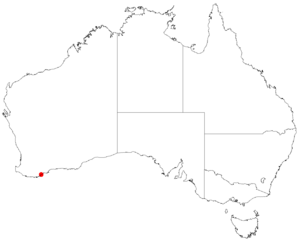Prostanthera verticillaris facts for kids
Quick facts for kids Prostanthera verticillaris |
|
|---|---|
| Conservation status | |
| Scientific classification | |
| Genus: |
Prostanthera
|
| Species: |
verticillaris
|
 |
|
| Occurrence data from AVH | |
Prostanthera verticillaris is a special kind of flowering plant. It's a type of mintbush that grows only in a small part of Western Australia. This plant is a spreading shrub with interesting leaves that grow in circles, and its flowers can be white or purplish-blue. It belongs to the Lamiaceae family, which also includes mint plants.
What Does It Look Like?
Prostanthera verticillaris is a shrub that spreads out and has branches that aren't too dense. It usually grows to be about 0.5–2 m (1 ft 8 in – 6 ft 7 in) tall. Its branches are covered in small hairs.
The leaves of this plant are quite unique. They grow in whorls, which means they form circles of three or four leaves around the stem. The leaves are mostly smooth, without hairs, and are shaped like an egg or an ellipse. They are about 9.5–11 mm (0.37–0.43 in) long and 4–6 mm (0.16–0.24 in) wide. Some leaves are attached directly to the stem (called sessile), while others have a very short stalk (a petiole) up to 1 mm (0.039 in) long.
Its Flowers
The flowers of Prostanthera verticillaris grow in groups of six to eight near the ends of the branches. Each flower has a short stalk, called a pedicel, which is about 2 mm (0.079 in) long.
The flowers have two main parts:
- Sepals: These are like small leaves that protect the flower bud. They form a tube about 3.5 mm (0.14 in) long. This tube has two parts, or lobes. The bottom lobe is about 2 mm (0.079 in) long, and the top lobe is about 4–4.5 mm (0.16–0.18 in) long.
- Petals: These are the colorful parts of the flower. They can be white or purplish-blue and are 9–12 mm (0.35–0.47 in) long. The petals form a tube with two "lips." The lower lip has a middle part that is shaped like a spatula, about 5.3–6.8 mm (0.21–0.27 in) long. The side parts of the lower lip are about 2.5 mm (0.098 in) long. The upper lip is egg-shaped, about 4 mm (0.16 in) long and wide, and has a small notch in the middle.
This plant usually blooms during the months of September and October.
How It Was Named
The plant Prostanthera verticillaris was first officially described in 1988. This was done by a scientist named Barry Conn. He wrote about it in a scientific journal called Nuytsia. The description was based on plant samples collected by Kenneth Newbey in 1967, from an area north-east of Albany.
Where It Grows
This special mintbush is very rare. It grows only on granite outcrops, which are areas where large rocks of granite stick out of the ground. It is only found in the exact place where the first samples were collected. This area is part of the Esperance Plains biogeographic region in Western Australia.
Conservation Status
Because Prostanthera verticillaris is found in so few places, it is considered a plant that needs protection. The Government of Western Australia's Department of Parks and Wildlife has classified it as "Priority One". This means that the plant is known from only one or a few locations, and these places could be at risk. Protecting these areas is very important to keep this unique plant safe.


